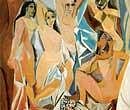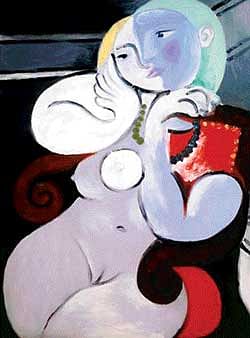

On Saturday January 8, 1927, a pretty 17-year-old was shopping in the fashionable Galeries Lafayette in Paris’ Boulevard Haussmann. She stood innocently transfixed in the big store taking in the City of Light’s sweetest luxury, a free fashion parade: Tall, leggy models flaunting haute-couture threads. Unknown to her a well-known impressionist painter-modern artist arrived on the scene, sighted the ‘blonde, sunny and bright’ beauty and couldn’t take his eyes off her. So smitten was he by love at first sight.
Even as the paparazzi exploded camera flash bulbs around him and fans waved pieces of paper for autographs or a chance hand-shake, Pablo Ruiz Picasso (1881-1973), the ‘first rock-star artist whose wild visions gripped the world’s imagination and changed 20th century art for ever’ was well and truly taken in by the ‘voluptuous’ teenager. Never mind that he was (a) 45, (b) married to a beautiful ballerina, Olga Khokhlova, and (c) a celebrity much in the public eye, the painter, draughtsman and sculptor threw caution to the winds and strode towards his quarry. What followed is history. And one of the most memorable pick-up lines, “Miss, you have an interesting face. I would like to do your portrait. I have a feeling we will do great things together. I am Picasso.”
The stunned young ‘innocent open-air girl’ Marie-Thérèse Walter (1910-1977) was left speechless, gasping but managed to smile. It was the beginning of romance, if a vexed one, of a remarkable artist and his model and muse. They would do great things together, the blonde and the famous painter.
Today they are back in the news for an entirely different reason. The painting from their 1932 series ‘Nude, Green Leaves and Bust’ (Nu au Plateau de Sculpteur, in French) has been sold at a New York City auction for US $106.5 million (about Rs 480 crores), setting up a new world record for a work of art sold at auction. The previous record-holder was Giacometti’s sculpture, ‘Walking Man I’ (1960) sold for $104.3 million, while yet another Picasso creation, ‘Garçon à la Pipe’ or ‘Boy with a Pipe’ (1905), was auctioned for $104.1 million, making ‘Nude…’ the most expensive painting sold at auction.
The ‘sensuous and stunning’ oil painting measuring 160cm x 130cm on a vibrant blue and lilac canvas was executed when Picasso was 50 years old. The painting depicts a profile of the artist on a pedestal observing the naked figure of Marie-Thérèse with philodendron leaves and some fruit in the background.
‘Nude…’ had been in the private collection of Los Angeles millionaire constructor and modern art lover, Sidney and Frances Brody since the 1950s, and was exhibited to the public only once, in 1961.
The story behind this, the most expensive artwork, is fascinating as it relates to the turbulent love affair of the middle-aged Picasso and the young Marie-Thérèse.
“Picasso pulled off this moment of seduction as if he were Zeus descending from Olympus and carrying off a young nymph who had caught his fancy,” says Michael Fitzgerald, describing the chance encounter of the model and artist in his essay, ‘Pablo Picasso: Picasso’s Marie-Thérèse’.
The birth of ‘Nude…’ can be traced to that evening when the wide-eyed teenager and the painter walked to a quiet corner for a little tête-à-tête in January 1927. Even while art history was being written, it was the beginning of a sizzling romance that shocked bohemian Paris. And as per biographer John Richardson the ‘genial genius’ who built up a reputation as ‘a predator who gobbled up visual stimuli and wolfed down friends, employees and lovers,’ Picasso had fallen obsessively in love. An affair that would continue for 10 years and produce a daughter, Maia or María de la Concepción in 1935.
After the first chance meeting, Picasso whisked off the pretty blonde the very next day in his chauffer-driven Hispano-Suiza Pourtout to a secret rendezvous. From there the pair kept meeting surreptitiously at all odd places and odd parts of the day. Even though Marie had taken up an apartment opposite the Picassos in 23, rue La Boetie and they frequently met, or later she spent long hours in the vast sculpture studio in the secluded Chateau de Boisgeloup some 40 miles away from Paris that Picasso acquired in 1930 — Olga had no clue to their romance. And she had no reason to doubt his fidelity.
Picasso played good husband to Olga who was the mother of his young son, Paulo, whom he adored. But the fact was otherwise. Throughout his life Picasso had a string of mistresses in addition to two wives and a primary partner. In all, Picasso sired four children by three women.
Despite these complex relationships and at a time when Olga was ‘difficult, demanding, even increasing unstable at times’, Picasso in his mid-forties was “desperate for an outlet, an escape into a sexual adventure that would rejuvenate his life and, as or even more importantly, stimulate his art. The beautiful and acquiescently sensual Marie-Thérèse filled both these needs to perfection,” says his biographer. And yet he didn’t marry her and carried on torrid love affairs with even younger women.
At about that time, in the Boisgeloup studio, Picasso worked on some of his finest still-life compositions — newly-cut wildflowers in glass pitcher, fruit grouped nearby, all laid out on a cloth-covered table-top and set before an open window. The same subjects were again essayed in ‘geometrically compartmentalised cubist space’. Experts opine that these canvases welcomed the rebirth of nature, and heralded the awakening of an excited and newly receptive state-of-mind. It was a time too when the residents of Boisgeloup threw open windows, “to let in the light of the lengthening days, to breathe in the freshly scented air and allow it to clear out the stuffy and smoky air from the large rooms of this old mansion.”
“The presence that hovers everywhere in this light-filled room is that of Marie-Thérèse Walter,” says FitzGerald.
In his work, Picasso depicted Marie-Thérèse's shapely and inviting figure in several ways: Seated with a vase of flowers, as a wild beauty, a sporty and healthy ‘beautiful plant’, as the first femme-fleur, on a divan among floral motifs. They are best represented in the series of stunning paintings and sculptures such as ‘Woman in the Garden’ (1929), ‘Girl Before a Mirror’ (1932), ‘Le Reve’ or ‘The Dream’ (1932), ‘Nude, Green Leaves and Bust’ (1932), ‘Nude in a Black Armchair’ (1932) and ‘Woman in Hat and Fur Coat’ (1937).
Be that as it may, the simple, sweet-natured girl remained passionately in love with him long after his affairs with other mistresses, says Richardson. On his death she was disconsolate and ended her life. Today the world remembers this warm hearted woman and long time companion as the dominant personality in the ‘Nude, Leaves and Bust’ picture.